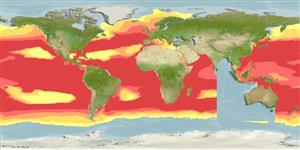Teleostei (teleosts) >
Carangiformes (Jacks) >
Echeneidae (Remoras)
Etymology: Remora: Latin, remora = delay, hindrance (1567) (Ref. 45335).
More on author: Lowe.
Environment: milieu / climate zone / depth range / distribution range
Ecology
Marine; pelagic-oceanic; oceanodromous (Ref. 51243). Subtropical
Circumglobal in tropical and warm temperate seas.
Size / Weight / Age
Maturity: Lm ? range ? - ? cm
Max length : 50.0 cm TL male/unsexed; (Ref. 55763); common length : 25.0 cm TL male/unsexed; (Ref. 55763)
Dorsal spines (total): 0; Dorsal soft rays (total): 27 - 34; Anal spines: 0; Anal soft rays: 25 - 34. Body cylindrical and elongate; possessing an oblong cephalic disk with 14 to 17 transverse laminae; cranium depressed (supporting cephalic disk); dorsal fin with 27 to 44 rays; first gill arch with fewer than 21 gill rakers; body entirely white to pale blue (Ref. 55763).
Found on the body and inside gill chamber of billfishes and swordfishes, rarely on any other fishes (Ref. 2850); also in the gill cavities and mouths of sharks (Ref. 5951).
Life cycle and mating behavior
Maturity | Reproduction | Spawning | Eggs | Fecundity | Larvae
Paxton, J.R., D.F. Hoese, G.R. Allen and J.E. Hanley, 1989. Pisces. Petromyzontidae to Carangidae. Zoological Catalogue of Australia, Vol. 7. Australian Government Publishing Service, Canberra, 665 p. (Ref. 7300)
IUCN Red List Status (Ref. 130435: Version 2024-1)
Threat to humans
Harmless
Human uses
Tools
Special reports
Download XML
Internet sources
Estimates based on models
Preferred temperature (Ref.
123201): 7.9 - 28.1, mean 23.4 °C (based on 1998 cells).
Phylogenetic diversity index (Ref.
82804): PD
50 = 0.5352 [Uniqueness, from 0.5 = low to 2.0 = high].
Bayesian length-weight: a=0.00257 (0.00110 - 0.00600), b=3.17 (2.96 - 3.38), in cm total length, based on LWR estimates for this (Sub)family-body shape (Ref.
93245).
Trophic level (Ref.
69278): 3.5 ±0.4 se; based on size and trophs of closest relatives
Resilience (Ref.
120179): Medium, minimum population doubling time 1.4 - 4.4 years (Assuming Fec < 10,000).
Fishing Vulnerability (Ref.
59153): Moderate vulnerability (40 of 100).
Nutrients (Ref.
124155): Calcium = 39.6 [12.5, 119.7] mg/100g; Iron = 1.21 [0.45, 6.66] mg/100g; Protein = 3.95 [0.22, 7.80] %; Omega3 = 0.269 [0.118, 0.593] g/100g; Selenium = 27.7 [6.4, 78.5] μg/100g; VitaminA = 6.37 [2.13, 20.36] μg/100g; Zinc = 0.752 [0.368, 1.431] mg/100g (wet weight);
